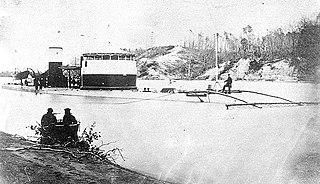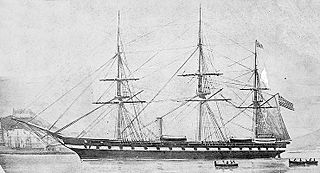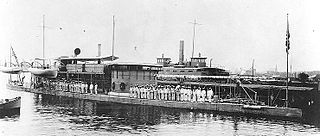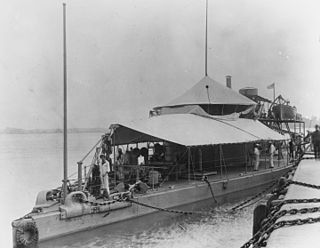
A monitor is a relatively small warship that is neither fast nor strongly armored but carries disproportionately large guns. They were used by some navies from the 1860s, during the First World War and with limited use in the Second World War.
USS Agamenticus was one of four Miantonomoh-class monitors built for the United States Navy during the American Civil War. Commissioned as the war was ending in May 1865, the ironclad saw no combat and was decommissioned in September and placed in reserve. The ship was reactivated in 1870, having been renamed Terror the previous year, and was assigned to the North Atlantic Fleet where she served in the Caribbean Sea. The monitor was decommissioned again in 1872 and was sold for scrap two years later. The Navy Department evaded the Congressional refusal to order new ships by claiming that the Civil War-era ship was being repaired while building a new monitor of the same name.

Huáscar is an ironclad turret ship owned by the Chilean Navy built in 1865 for the Peruvian government. It is named after the 16th-century Inca emperor, Huáscar. She was the flagship of the Peruvian Navy and participated in the Battle of Pacocha and the War of the Pacific of 1879–1883. At the Battle of Angamos, Huáscar, captained by renowned Peruvian naval officer Miguel Grau Seminario, was captured by the Chilean fleet and commissioned into the Chilean Navy.

USS Onondaga was an ironclad monitor built for the Union Navy during the American Civil War. Commissioned in 1864, the ship spent her entire active career with the James River Flotilla covering the water approaches to the Confederate States capital of Richmond, Virginia, although her only notable engagement was the Battle of Trent's Reach. After the war, she was purchased by France where she served as a coastal defense ship in the French Navy.

USS Canonicus was a single-turret monitor built for the United States Navy during the American Civil War, the lead ship of her class. The ship spent most of her first year in service stationed up the James River, where she could support operations against Richmond and defend against a sortie by the Confederate ironclads of the James River Squadron. She engaged Confederate artillery batteries during the year and later participated in both attacks on Fort Fisher, defending the approaches to Wilmington, North Carolina, from December 1864 to January 1865.
The first USS Miantonomoh was the lead ship of her class of four ironclad monitors built for the United States Navy during the American Civil War. Completed after the war ended in May 1865, the ship made one cruise off the East Coast before she began a voyage across the North Atlantic in May 1866 to conduct a lengthy showing the flag mission in Europe. Miantonomoh was decommissioned upon her return in 1867, but was reactivated two years later and assigned to the North Atlantic Squadron before decommissioning again in 1870. The monitor was sold for scrap three years later as part of a scheme where the Navy Department evaded the Congressional refusal to order new ships by claiming that the Civil War-era ship was being repaired while building a new monitor of the same name.

USS Saugus was a single-turreted Canonicus-class monitor built for the Union Navy during the American Civil War. The vessel was assigned to the James River Flotilla of the North Atlantic Blockading Squadron upon completion in April 1864. The ship spent most of her time stationed up the James River where she could support operations against Richmond and defend against a sortie by the Confederate ironclads of the James River Squadron. She engaged Confederate artillery batteries during the year and later participated in both attacks on Fort Fisher, defending the approaches to Wilmington, North Carolina, in December 1864 – January 1865. Saugus returned to the James River after the capture of Fort Fisher and remained there until Richmond, Virginia, was occupied in early April.

USS Roanoke was a wooden-hulled Merrimack-class screw frigate built for the United States Navy in the mid-1850s. She served as flagship of the Home Squadron in the late 1850s and captured several Confederate ships after the start of the American Civil War in 1861. The ship was converted into an ironclad monitor during 1862–63; the first ship with more than two gun turrets in history. Her conversion was not very successful as she rolled excessively and the weight of her armor and turrets strained her hull. Her deep draft meant that she could not operate off shallow Confederate ports and she was relegated to harbor defense at Hampton Roads, Virginia for the duration of the war. Roanoke was placed in reserve after the war and sold for scrap in 1883.

USS Puritan was one of two ocean-going ironclad monitors designed by John Ericsson during the American Civil War of 1861–1865. Launched in mid-1864, construction was suspended sometime in 1865. The Navy Department had specified two twin-gun turrets over Ericsson's protests, but finally agreed to delete the second turret in late 1865. The Navy Department evaded the Congressional refusal to order new ships in 1874 by claiming that the Civil War-era ship was being repaired while building a new monitor of the same name.

USS Ozark was a single-turreted river monitor built for the United States Navy during the American Civil War. The ship served in the Mississippi River Squadron during the war, and participated in the Red River Campaign shortly after she was commissioned in early 1864. Ozark patrolled the Mississippi River and its tributaries after the end of the campaign for the rest of the war. She was decommissioned after the war and sold in late 1865.

USS Catawba was a single-turreted Canonicus-class monitor built for the Union Navy during the American Civil War. Completed shortly after the end of the war, Catawba was laid up until sold to her builders in 1868, and then resold to the Peruvian Navy. Renamed BAP Atahualpa, the ship participated in the defense of main port of Peru, Callao, during the War of the Pacific. When the city of Lima was taken by Chilean troops in 1881, she was scuttled to prevent her capture. Atahualpa was later refloated and used as a storage hulk until scrapped in the early 20th century.

Originally named USS Tippecanoe, after the river in Indiana, USS Wyandotte was a single-turreted Canonicus-class monitor built for the Union Navy during the American Civil War. Completed after the end of the war, Wyandotte was laid up until 1876, although she received her new name in 1869. The ship was commissioned in 1876 and assigned to the North Atlantic Squadron for the next three years. She became a receiving ship in 1879 until she was placed in reserve again in 1885. Wyandotte was on militia duty when the Spanish–American War began and she was recommissioned in 1898 to defend Boston, Massachusetts from any Spanish raiders. The ship was decommissioned after the end of the war and sold for scrap in 1899.

USS Ajax, originally named USS Manayunk after a town in Pennsylvania, was a single-turreted Canonicus-class monitor built for the Union Navy during the American Civil War. Completed after the end of the war, Ajax was laid up until 1871, although she received her new name in 1869. The ship was briefly activated in 1871, before a much longer commission began in 1874–1875. She was assigned to the North Atlantic Squadron during this time. Ajax was again placed in reserve in 1891. The ship was on militia duty when the Spanish–American War began and she was recommissioned in 1898, to defend Baltimore, Maryland, although she was decommissioned later in the year before the necessary refit could be completed. Ajax was sold for scrap in 1899.

USS Manhattan was a single-turreted Canonicus-class monitor built for the Union Navy during the American Civil War. After commissioning in 1864 the ship was assigned to the West Gulf Blockading Squadron and participated in the Battle of Mobile Bay. At the end of the battle, Manhattan took the surrender of the Confederate casemate ironclad ram Tennessee. She bombarded Fort Morgan during the Siege of Fort Morgan and later blockaded the mouth of the Red River until the end of the war.

USS Mahopac (1864) was a Canonicus-class monitor built for the Union Navy during the American Civil War. The vessel was assigned to the James River Flotilla of the North Atlantic Blockading Squadron upon completion in September 1864. The ship spent most of her time stationed up the James River where she could support operations against Richmond and defend against sorties by the Confederate ironclads of the James River Squadron. She engaged Confederate artillery batteries during the year and later participated in both the first and second battles of Fort Fisher, defending the approaches to Wilmington, North Carolina, in December 1864 – January 1865. Mahopac returned to the James River after the capture of Fort Fisher and remained there until Richmond, Virginia was occupied in early April.

The Canonicus-class monitor was a class of nine monitors built for the Union Navy during the American Civil War. They saw service in the Civil War and the Spanish–American War, although two of them were never commissioned.

The Naval campaign of the War of the Pacific or Saltpeter war, was a naval campaign that took place from 1879 to 1884, involving Peru, and Chile, undertaken in order to support land forces in the Atacama Desert. Although the conflict lasted until 1884, the primary naval engagements occurred between 1879 and 1880. Due to the rough terrain and few transport methods it was imperative to have control of the ports in order to have a good supply source in the region. It resulted in a successful campaign by Chile, and the success of their land campaigns eventually led to a Chilean victory, which cut off Bolivia's access to the coast.

The Naval Battle of Arica was a naval battle which took place on 27 February 1880 during the Blockade of Arica as part of the War of the Pacific.

The Rupture of the Blockade of Arica was a naval battle of the War of the Pacific during the Blockade of Arica. The rupture was carried out by Manuel Villavicencio who commanded the BAP Unión of the Peruvian Navy. The Unión broke the Chilean blockade of the port twice in less than 8 hours on March 17, 1880.
















